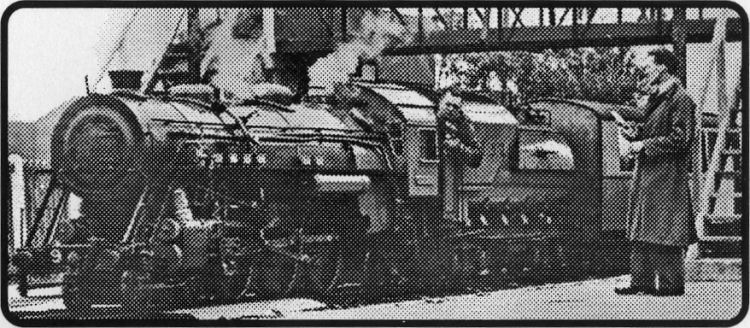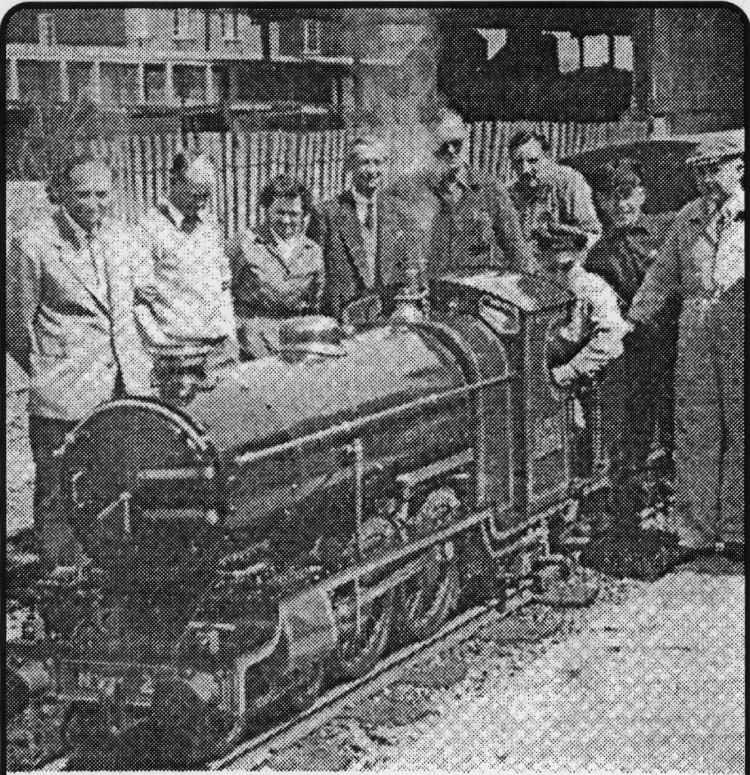
Published 28 February 2002

Jubilee year
I WAS interested to hear this week that the "Sutton Flyer," a steam
locomotive that once ran as an experiment on the popular Romney, Hythe &
Dymchurch Railway, and was the first 'outsider' to guest on the line, has
been brought out of mothballs to entertain holidaymakers on another coastal
resort railway in miniature.
The ‘Sutton Flyer" used to be one of the regular engines on the now closed
Sutton Miniature Railway, at Sutton Park, Sutton Coldfield, near Birmingham.
Sutton Town Council's refusal to renew the railway's lease, back in 1962,
forced closure of that line and “Sutton Flyer" and its sister locomotive
“Sutton Belle" went into store at the Hunt family's engineering works at
Hunt Foundries Ltd, in Oldbury.
Lottery lifeline
The Hunts, Tom and son Bill, now 82, had hoped to find a new site for the
railway, but there was no joy, as they say, until Lottery funding enabled
Cleethorpes Coast Light Railway, in Lincolnshire, already running 15 inch
gauge trains, to buy the old Sutton Railway stock.
This came as a great relief to Bill, who was desperate to find the engines a
good home.
My informant, Stephen Nash, of Hook Close, Folkestone, a freelance writer,
tells me the two locomotives will retain their Sutton identities and
liveries, rather than be absorbed into the Cleethorpes Coast Light Railway's
'fleet.'
So, in effect, he comments, the Sutton Park Miniature Railway will undergo a
reincarnation at Cleethorpes.
Fellow railway enthusiasts will be interested to know the CCLR hopes the
augmented Cleethorpes
line will become a major centre for heritage 15 inch gauge stock. (I
remember taking my son to see this seafront line when he was a youngster.)
Who knows, Stephen speculates, perhaps the “Sutton Flyer" will get to make a
return trip to New Romney.
It was way back in 1957 that George Barlow, B.E.M., a highly respected
Romney, Hythe & Dymchurch Railway driver, manager and miniature railway
expert, visited Sutton Miniature Railway and suggested one of its new
Atlantic class engines should visit the Marsh line for trials.
The Sutton Park railway was too short to allow the locomotives to have a
good run so MrT.G. Hunt agreed and, with Captain Howey's blessing the royal
blue liveried "Sutton Flyer," which dated from 1950, arrived at New Romney
on June 1, 1959.
And, pictured right, is the Folkestone Herald's front page photo I found in
the files, of June 6.
The locomotive, fitted with special buffers, steamed at New Romney and then
spent a day running around the station before taking a four-coach test train
to Hythe behind the day's last Up train.
It could not haul a public train, apparently, because it was not fitted with
vacuum brake equipment and therefore could not operate the brakes of the
Marsh line's coaches.
The following day, Wednesday June 3, the gleaming engine was allowed to run
up and down the railway all day with three coaches. The trials resulted in a
maximum speed of 27mph.
Nothing higher was attempted because of insufficient stability at the front
end of the locomotive, which meant there was a risk of derailment.
The "Sutton Flyer" left the Marsh railway on Friday, June 5 to return to its
duties at Sutton Park.
By a remarkable coincidence an e-mail message arrived at my Tilmanstone home
on Tuesday, from a miniature railway enthusiast and long-term reader of
Memories. Mike Neighbour.
Mr. W. T» Hunt at the controls of the Sutton Flyer on Wednesday. He and his
father, on the right, built the engine,
There’s A Stranger Or The Little Railway
He said he started buying the Herald in the early 80s and used to have it
delivered to his former address in Reading.
He goes on to point out that this is the Diamond Jubilee year of the Romney,
Hythe & Dymchurch Railway and suggested other Memories readers would be
interested in a photograph and/or an article on "our local famous tourist
attraction." Well, I am pleased to oblige. The top souvenir postcard photo
is of "Dr Syn" at Dymchurch.
HERALD reader Mike Newth, a writer, was impressed with the walk down memory
lane in our February 14 edition.
He writes of a "pictorial delight blazing" from my Memories page. (No one
has ever expressed their appreciation quite like that beforel)
It wasn't the brilliance of the old picture - of young people enjoying a
barn dance - but the memories that flooded back of a charity event of 1956
in aid of the Hungarian Relief Fund.
Mike writes: "I remember the barn dance evening well, being one of a group
from W.H. Smith & Son, when the shop was at 86 Sandgate Road.
"Work colleagues pictured include Ruby Stone, Olive Green, Mary Wratten, Pat
Hurrell and Barry Newall.
"I am pictured back row, second from left. - Happy days," he commented.
In fact we have Old Harveian Kevin Edwards, of Geraldine Road, Folkestone to
thank for a newspaper cutting of the Herald photo. No negative can be found
of the picture.
Mills talk
Windmills and watermills, a special interest of mine, are to feature at the
next meeting of Folkestone &■ District Local History Society, at Holy
Trinity Church hall, Sandgate Road, at 7.30pm. The speaker is Paul Jarvis,
the title of his presentation being "Kent Mills."

 |
Earl offers to give up land to assist town expansion
#t QAQ LORD Radnor backed the scheme for widening Cheriton Ru.irt. from
Folkestone to Cheriton, on the grounds that it would boost housing
development in that area, and disclosed at a public inquiry that he
owned moro than half the land that the town stood on, and probably paid
more rates than any other person in Folkestone - representing a
fourteenth of the total. He added that he was willing to give up land to
assist in the town's development. Probably acting in response to public
opinion, members of Cheriton Urban District Council n-scindi-il a
decision made at a meeting just before Christmas to save money by
cutting street lighting by half after midnight. Some councillors and
local residents objected to reduced security and the increased risk of
accidents. The Coronation of King Edward VII was seen by many local
people as an opportunity to encourage more visitors to come to
Folkestone and Hythe and the editor urged prompt action to target those
thousands of people who would visit the UK to join in n.itioiiiil
celebrations. He suggested a local tourist guide with text in three
languages for Channel steamer passengers.
|
Visitor to rescue as straying horses risk Leas cliff plunge
«f Q07 CYRIL Dart, .1 visitor, was coinniendcd after I he caught three
army horses which had escaped and galloped their way to the Leas from
Shorncliffe. The Hussars' horses, they had caroered up Sandgate Hill,
down Sandgnte Road and along Earls Avenue and came close to plunging
over the cliff but commenced to jump hurdles which separated green
plots, instead. An experienced horseman,the visitor cornered the animals
on a narrow path and secured them with a rope. The Herald told of an
alarming new trend -that of a growing tide of people taking their
holidays abroad, which posed a serious threat to all resorts. It was
seen as a serious menace and a report on “The Future of English Seaside
Resorts" read at a local meeting warned of the danger of placing
“grandmotherly" restrictions in the path of holidaymakers, such as
absurd restrictions on hours for entertainment and Sunday observance.
The editor also pointed to one particular local need that the Herald had
been urging for years - a swimming pool where visitors and local people
could go swimming at any state of the tide or weather. Capt CT Courtney,
who had flown at Lympne airport, was recovering after crashing while
testing a new auto-eiro (helicopter) ‘'windmill” plane at Southampton.
|
Test decided if children of 14 could start work
A Q CO HILLSIDE Secondary School, formerly •l.S/0^the Dover Road School,
produced its first magazine, called "EndiMvnur,” one feature telling of
the old “Labour" exam which decided whether a boy could leave school
before the age of 14, as many did in years gone by. One “Old Boy" who
made good was Sir Eustace Missenden. who became Chairman of the Railway
Executive running the nation's railways. Incidentally the first Dover
Road school was a disused workhouse that stood on the site of Hillside.
The Commander in Chief of the UN Command in Korea General Ridgway sent a
letter of sympathv to Mrs Heron, widow of Cpi James Heron who died of
wounds received in the fighting in that country. The old boy of the
George Spurgen School was in the Norfolk Regiment, his parents living in
Calgary Crescent. Folkestone. Folkestone Orpheus Choir, conducted by
Reginald Adams and accompanied at the organ by Wilfrid Holland gave a
very good performance of the difficult and exacting Brahms' “Requiem."
in the parish church. Over 200 players from all over the South of
England made over 350 entries for the Kent Open Championships staged at
the Marine Gardens Pavilion, in Folkestone over two
|
Hythe nuns in battle over redundancy at St Saviours
>f Q77NUNS who resigned in protest from their JmiJ / / work at Si
S.iiimir's Hospital, Hythe, in December, were at the crntrc of a new
storm. The row was over an offer of L5.UU0 “redundancy" money after the
Community of the Presentation, a Church of England nursing order, had
quit. Dr Celia Culver-Evans. a former member of the management
committee, who championed the nuns' cause, described the offer as
"derisory." Many people living along the Sunshine Coast of East Kent,
from Folkestone to Dungencss have questioned the commercial exploitation
of shingle along the coast, arguing that it leads to heavy bills for
coast protection as the sea pounds and scours the sea defence works. And
25 years ago the fishermen of Dungencss pointed out they had been
campaigning for a better deal for 10 years, as they protested about the
considerable extra work it created for them in launching their boats on
top of the normal hazards of their trade. Their major protagonists were
the Central Electricity Generating Board which contracted the Southern
Water Authority to extract vast quantities of shingle from one side of
the "Point" to protect their property on the other side, an operation
that had gone on for 10 years. Work on the Folkestone to Sellindge
stretch of the M20 was put back to spring 1978 in Government cutbacks in
public spending - 12 months later than promised back in August. |
|



